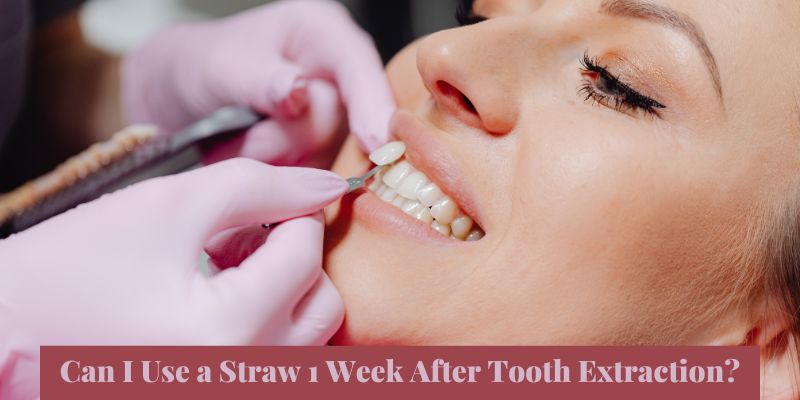Tooth extraction is a common dental procedure that involves the removal of a damaged or decayed tooth. After undergoing this process, it is essential to follow proper care instructions to ensure optimal healing and prevent complications. One common concern that arises post-extraction is whether it is safe to use a straw. In this article, we will discuss the topic in detail, providing step-by-step guidance and useful tips for Use a Straw 1 Week After Tooth Extraction.
Use a Straw 1 Week After Tooth Extraction {Guidelines to Keep in Mind}
Here are some guidelines to keep in mind if you are considering using a straw 1 week after tooth extraction:
Consult your Dentist
Before considering using a straw following a tooth extraction, it is crucial to consult your dentist or oral surgeon. Every case is unique, and your dental professional will provide personalized advice based on your specific circumstances. They will consider factors such as the complexity of the extraction, the location of the extracted tooth, and your overall oral health.
Follow the Immediate Post-Extraction Guidelines
During the first few days after a tooth extraction, it is crucial to follow the immediate post-extraction guidelines provided by your dentist. These guidelines may include avoiding strenuous activities, refraining from consuming hot or spicy foods, and abstaining from smoking or using tobacco products. Following these instructions diligently will promote healing and reduce the risk of complications.
Time Frame for Straw Use
Typically, it is recommended to wait at least 24 hours before using a straw after tooth extraction. This allows the initial blood clot to form, protecting the extraction site. However, using a straw too soon may dislodge the clot, leading to a condition called dry socket, which can be painful and delay the healing process. Therefore, it is advisable to wait for about a week before considering the use of a straw.
Be Mindful of the Suction
When using a straw, there is a risk of creating suction in the mouth, which can disrupt the healing process. To minimize this risk, follow these precautions:
Use a Wide Straw
Opt for a wide-diameter straw, as it reduces the amount of suction created compared to a narrower one.
Position the Straw Correctly
Place the straw toward the front of your mouth, allowing you to drink without generating excessive suction near the extraction site.
Do Not Create Strong Suction
Avoid sucking forcefully through the straw. Instead, gently sip or use the straw to guide liquids into your mouth without generating excessive pressure.
Avoid Carbonated Beverages
Carbonated drinks produce bubbles, which can create additional suction. It is best to avoid them during the initial phase of recovery.
Position the Straw Carefully
When using a straw, make sure to position it in a way that minimizes contact with the extraction site. Place the straw toward the back of your mouth, away from the socket.
Avoid Strong Suction
Do not create strong suction when using a straw. Instead, take gentle sips without creating excessive pressure in your mouth. This precaution helps to avoid dislodging the blood clot.
Choose Appropriate Beverages
Stick to cold or lukewarm beverages rather than hot ones. Avoid carbonated drinks and alcoholic beverages, as they can irritate the extraction site.
Maintain Proper Oral Hygiene
Good oral hygiene is essential for a successful recovery after tooth extraction. Gently brush your teeth twice a day, making sure to avoid the extraction site. Rinse your mouth with warm saltwater (a teaspoon of salt in eight ounces of water) after meals to keep the area clean and free from bacteria.
Listen to Your Body
Pay close attention to any discomfort or pain while using a straw. If you experience increased sensitivity, pain, or bleeding around the extraction site, stop using the straw immediately and consult your dentist. They will assess the situation and provide further guidance on adjusting your post-extraction routine.
You may also like:-
10 Celebrities With Yellow Teeth
Does Coffee Cause Bloating and Gas
How to Stop Skin Peeling Inside Mouth?
Conclusion
While it is generally advised to avoid using a straw for at least a week after tooth extraction, it is important to consult your dentist for personalized advice. Following the correct timeline, being mindful of suction, and maintaining good oral hygiene will help ensure a smooth recovery. Remember to listen to your body and seek professional guidance if any concerns arise. By following these guidelines, you can minimize the risk of complications and promote the healing process.
It is crucial to note that every individual’s recovery may vary, and your dentist will provide specific instructions based on your unique situation. Their expertise and guidance will help you make informed decisions regarding the use of a straw and ensure the best possible outcome for your oral health.
Prioritizing your post-extraction care will not only protect the extraction site but also contribute to your overall oral well-being. So, take the necessary precautions, stay vigilant, and enjoy a speedy recovery.
